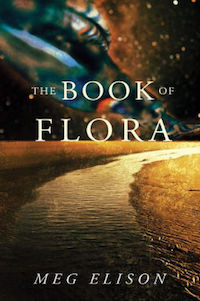Charlie Jane Anders has a secret notebook full of background information, histories, linguistics, and might-have-beens about her book, The City in the Middle of the Night. And you will never see it.
You shouldn’t ever see it. Even if you are her biggest fan, even if she is one day enticed by ample money or sweet-talked into publishing it as bonus content, even if her heirs are tempted and desperate enough to do the same, these notes should never become part of your reading experience.
I know about this notebook because she and I engaged in one of my favorite forms of performance recently: a conversation between authors as peers staged to look and feel intimate, in a packed bookstore full of fans. This type of event is typically referred to as an “In Conversation With.” I was in conversation with Charlie Jane, and she was gracious enough to share some juicy facts about her process of writing The City in the Middle of the Night. In the course of that conversation, she mentioned these vast, unpublished parts to the story. I was unsurprised.
Part of my acceptance in that moment was that I know Charlie Jane and I respect her commitment to fervid and extensive research into her novels. The other part is more complicated, and something that most folks who aren’t writers might not know… Every book is the tip of an iceberg. Most of what an author knows, through research and through experience, is ballast to fiction. What is written and what is published are a tiny sliver of all that exists. Every writer you have ever read and loved is ninety percent unpublished underwater knowledge, and ten percent ghostly blue published prose.
The first part of that iceberg, the deepest and least-known layer, is made up of garbage. This includes failed drafts, other versions of the story where the point of view character was someone less compelling, or maybe the whole thing written in third person rather than first. It’s wads in the bottom of a digital trash can.
It’s also fan fiction, teenage poetry, old blog posts, and the roughly million words of crap most writers have to process out before they even start to get good. Some of it belongs to the book you end up reading, but a lot of it doesn’t. Many writers topping the bestseller list right now—including Seanan McGuire, Neil Gaiman, and Naomi Novik—honed their craft in writing fanfiction. There’s no shame in that, but it’s never part of the book that gets published. It’s essential, and the book would not exist without it. But it’s part of the vast, unseen body of work that keeps it afloat.
The middle layer is made up of experience. Most writers held a number of other jobs in their lives, and that work often informs the creative work. Most of us write stories that draw from what we know about the logistics of frying chicken and tater tots at the same time. We write crime fiction based on the years we spent in the dispatcher’s chair, listening to emergency calls. I myself worked in home improvement warehouses for the better part of a decade, and what I know about hinges and drywall and the shelf life of paint directly informed my work in all my novels so far.
Life experience outside of work also figures into the great bulk of this underwater section of the iceberg. Writers often hold in our disappointment, our rage. We keep these feelings as the earth keeps organic material and slowly converts it into something that will burn. We write about the despair we swallow when someone thinks they get to decide who gets to be people, as N.K. Jemisin does in the Broken Earth series. We hold on to the singular experience of heartbreak and explain it through time travel, as Sandra Newman does in The Heavens. We mull for years over the meaning of forgiveness in an abusive relationship and then we spin those years into galaxies of gold, as T.J. Berry does in Space Unicorn Blues.
The topmost underwater layer is the one the reader can almost see. It’s the one that writers talk about at events and in interviews, when someone asks about research and the process and where they might find that dread well from which writers draw ideas but refuse to draw a map. This is the one that Charlie Jane was willing to indicate, just pointing to what’s beneath the water and tell us it’s there. For her, it’s a notebook she carried for years, filled with details that she as the author must know, but will never find a place to belong in the book itself. For writers like her, it’s the foreign language we developed for a people to speak. It’s the maps drawn in grains of rice traced with a fingertip to shape the city, or drawn on butcher paper tacked up to the wall to serve as a vision board while the work is ongoing. It’s character details that open up a whole way of thinking about how a person will react to stress, like knowing they were burned as a child and that it made them fearful, or they can’t carry a tune but it’s kind of charming that they try. There is sometimes no scene in the book that needs this information, but the author’s got to know it anyway.
Buy the Book


The Book of Flora
For me, these submerged layers are the better part of worldbuilding. Cities in my books are a palimpsest of places I have lived, improved by the ways I wish they worked and tortured by the worst I’ve seen them do. I build them by reading history and newspapers and eavesdropping on the subway. I find one instance or one image that seems to encapsulate it all, and that’s the extent of what I tell the reader. People are quilts made up from scraps of folks I know, their mannerisms and their moments. Their speech patterns are taken from actors and poets and ideas I had about how a smuggler ought to speak, cut into new shapes and sewn together into a square. The saying that there’s nothing new under the sun was old when it was included in the Bible. All our art is made out of something else. Novels are no different.
Like Charlie Jane Anders, every writer has a vast, secret reserve of everything that went into a novel. Sometimes, it’s as simple and concrete as a notebook or a series of concordance files or a lot of notes in Scrivener. Most of the time, it’s a vast network of experiences, influences, and inspirations, some of which aren’t plainly and consciously known to us. Sometimes, this work can be shared for the benefit of completionists and obsessive fans. But I believe that Charlie Jane’s approach of keeping the water level high and keeping the notebook to herself is the correct impulse.
When readers get too deep below the surface, the waters get murky. Sometimes it can be instructive and fascinating, like The Silmarillion. Other times, though, we end up with the post-Potter revelations of J.K. Rowling. The part of the iceberg that’s below the water can tear the belly out of your ship and sink your ability to enjoy what’s published. Give it a little space and let it awe you on its own terms.
Every iceberg is a marvel. Every published book is a prodigious effort, and there is always more labor to it than the reader can or should see. Enjoy the marvel for what it is; delve deeply and sail around it on all sides, if you can. But know that what’s underwater is there for a reason. The most important and difficult part of that effort is deciding what to push above the surface and what should remain below. Charlie Jane Anders knows what belongs in The City in the Middle of the Night and what belongs in her notebook.
Trust her.
Trust me.
Trust the story.
Photo: Dake (CC BY-SA 2.5)
Meg Elison is a Bay Area author and essayist. Her debut novel, The Book of the Unnamed Midwife, won the 2014 Philip K. Dick Award and was listed as a Tiptree Committee recommendation. Additional novels in The Road to Nowhere series include The Book of Etta and The Book of Flora, publishing April 23rd with 47North. She is the first college graduate in her family, after finishing her BA in English at UC Berkeley in 2014. She spoke at her graduation. She writes like she’s running out of time and lives in Oakland.










